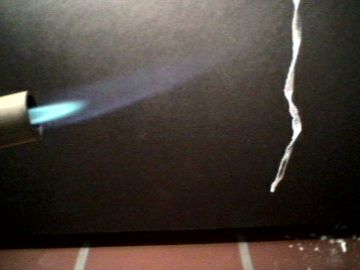



| 1. |  |
2. |  |
| Magnesium before being ignited | Magnesium as it ignites | ||
| 3. |  |
4. |  |
| Magnesium as it burns | Burning residue, magnesium oxide |
| Photo 1: | A magnesium ribbon is ignited with the help of a Bunsen burner. |
| Photo 2: | Burning begins. Magnesium reacts with oxygen in a strongly exothermic reaction according to:
2Mg + O2 > 2 MgO |
| Photo 3: | The magnesium burns. Temperatures during burning can go as high as 2400 °C. This lead to the magnesium oxide heating up to a white glow. The flame is so bright that objects bathed in magnesium light throw deep shadows even when they're in sunlight. |
| Photo 4: | Reaction product: magnesium oxide. |
This reaction was used in the early days of photography in the so-called "lightning powder," which contained magnesium powder and an oxidizing agent, such as calcium chloride (see Experiment 4.4.26).